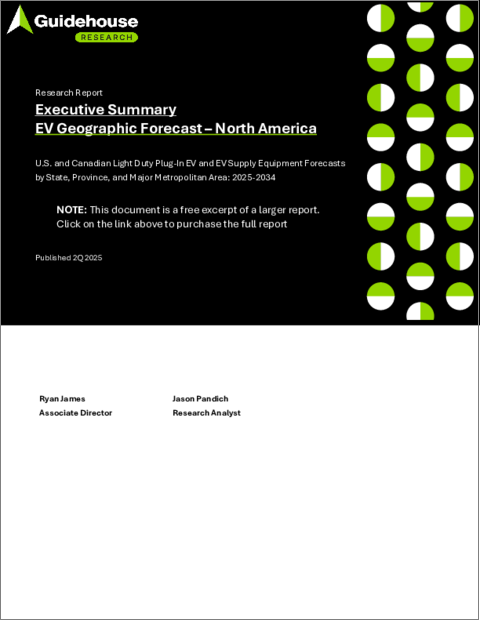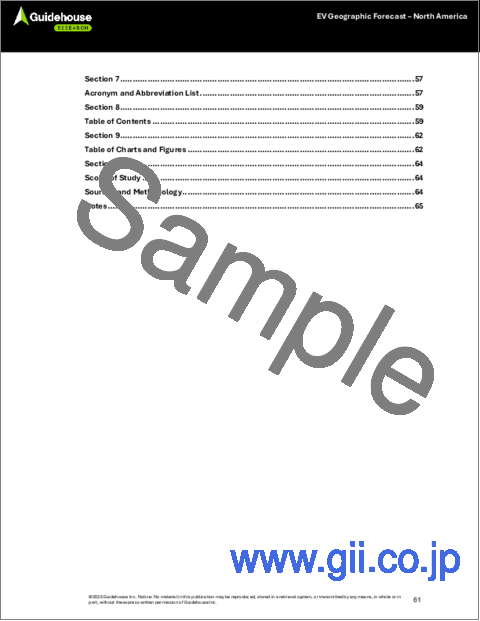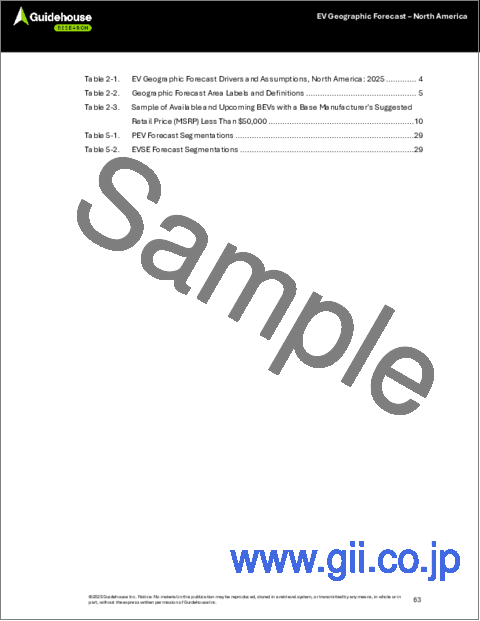|
|
市場調査レポート
商品コード
1745110
EVの地域別予測 - 北米EV Geographic Forecast - North America: U.S. and Canadian Light Duty Plug-In EV and EV Supply Equipment Forecasts by State, Province, and Major Metropolitan Area, 2025-2034 |
||||||
|
|||||||
| EVの地域別予測 - 北米 |
|
出版日: 2025年06月06日
発行: Guidehouse Research
ページ情報: 英文 66 Pages
納期: 即納可能
|
全表示
- 概要
- 目次
北米では近年、プラグイン電気自動車(PEV)の販売台数が増加を続けており、2024年には過去最高を記録しました。しかしながら、インフレ率の上昇と原材料価格の高騰により、需要は予想を下回りました。その結果、一部の自動車メーカーは電動化計画を見直しました。しかし、2021年インフラ・雇用促進法(Infrastructure and Jobs Act of 2021)および2022年インフレ抑制法(Inflation Reduction Act of 2022)による投資によって生産能力の増強が促進され、また、バッテリーパックのコスト低下が予想されることから、PEVの初期コストの低減が見込まれるため、PEVは北米自動車市場で引き続き成長すると予想されます。
PEVの成長を支えてきた政策環境は、米国の新政権下で大きな変化に直面する可能性が高いです。新政権は、燃費効率を向上させる政策や、PEVおよびEV供給装置(EVSE)のサプライチェーンに対する連邦政府の資金援助を打ち切る方針を示しています。自動車、自動車部品、半導体、鉄鋼に導入された関税は、ほぼすべての米国貿易相手国に対する一般的な関税とともに、北米の自動車産業に大きな混乱をもたらすことも予想されます。
当レポートでは、EV技術、イノベーション、インセンティブ、政策、車両の入手可能性を分析し、米国とカナダにおけるPEVの普及状況を国、州、準州レベルで予測しています。予測は、バッテリーパックと技術のイノベーション、燃料価格、モデルの入手可能性、ゼロエミッション車(ZEV)規制などに基づいています。この予測は、バッテリーパックや技術の革新、燃料価格、モデルの供給状況、ゼロエミッション車(ZEV)の義務化によって左右されます。乗用車と小型トラックのセグメントに加え、バッテリーEV(BEV)、プラグインハイブリッドEV(PHEV)、ハイブリッドEV(HEV)のパワートレイン区分も含まれます。EVSEの導入予測は、技術別(レベル1[L1]、レベル2[L2]、DC急速充電器)、使用事例別(フリート、公共施設、集合住宅(MUD)、単独住宅(SUD)、SUD共有住宅、職場)に区分されています。
目次
第1章 エグゼクティブサマリー
- イントロダクション
- 市場予測
第2章 市場の問題
- イントロダクション
- 市場促進要因、抑制要因、最新情報
- バッテリーパックの価格
- 燃料価格
- 自動車OEM PEV投資
- モデルの入手可能性
- PEV政策環境
- EVSE政策環境
第3章 産業バリューチェーン
- 競合情勢
- バリューチェーンの図解
- ビジネスモデルの進化
- オンショア生産
- サプライチェーンの統合
- その他の注目すべき業界の動向
第4章 予測調査手法
- 車両分析およびシミュレーションツールモデルの概要
- 長期的な市場シェア:パワートレイン間の競合
- インフラ整備と自動車普及の促進
- 自動車販売予測とモデルキャリブレーション
- 地理的特異性
- VAST充電器設置モジュールの概要
第5章 市場予測
- イントロダクション
- 米国
- PEV予測
- EVSE予測
- 州別予測
- 上位10都市圏
- カナダ
- PEV予測
- EVSE予測
- カナダの州別予測
- 上位10都市圏
第6章 結論・提言
- 3つの大きなポイント
- 推奨事項
- 自動車メーカー
- 政府
- バッテリーメーカー
- EVSEサプライヤー、オペレーター、メーカー
- ユーティリティ
第7章 頭字語と略語一覧
第8章 目次
第9章 図表
第10章 範囲、情報源、調査手法、注記
Sales of plug-in EVs (PEVs) have continued to increase in North America during recent years, with 2024 sales setting a new high. Despite this growth, demand was weaker than expected due to higher inflation and lingering volatility in the cost of raw materials. As a result, some automakers reevaluated their electrification plans. However, PEVs are expected to continue to be a growing piece of the North American vehicle market due to increases in production capacity spurred by investments from the Infrastructure and Jobs Act of 2021 and Inflation Reduction Act of 2022, and from an expected decrease in battery pack costs, which are likely to reduce the upfront cost of PEVs.
The policy environment that has helped PEV growth is likely to face significant change under the new U.S. administration, which has indicated plans to end policies that improve fuel efficiency as well as federal funding for PEV and EV supply equipment (EVSE) supply chains. Tariffs introduced on automobiles, auto parts, semiconductors, and steel, along with general tariffs on nearly all U.S. trading partners, are also expected to cause significant disruption to the North American auto industry.
This Guidehouse Insights report analyzes EV technology, innovations, incentives, policies, and vehicle availability to forecast PEV adoption in the U.S. and Canada on the national, state or province, and sub-state or sub-province levels. The forecasts are driven by battery pack and technology innovations, fuel prices, model availability, and zero emission vehicle (ZEV) mandates. They include passenger car and light truck segmentation in addition to powertrain breakouts by battery EVs (BEVs), plug-in hybrid EVs (PHEVs), and hybrid EVs (HEVs). Forecasts for EVSE deployments are segmented by technology (Level 1 [L1], Level 2 [L2], and DC fast chargers) and use cases, including fleet, public, multiuse dwellings (MUD), single-use dwellings (SUD), SUD-shared residences, and workplace.
Table of Contents
1. Executive Summary
- 1.1 Introduction
- 1.2 Market Forecast
2. Market Issues
- 2.1 Introduction
- 2.2 Market Drivers, Barriers, and Updates
- 2.2.1 Battery Pack Prices
- 2.2.2 Fuel Prices
- 2.2.3 Automotive OEM PEV Investment
- 2.2.4 Model Availability
- 2.2.5 PEV Policy Environment
- 2.2.5.1 Incentives
- 2.2.5.2 Regulations
- 2.2.5.3 Tariffs
- 2.2.6 EVSE Policy Environment
3. Industry Value Chain
- 3.1 Competitive Landscape
- 3.2 Pictorial Representation of the Value Chain
- 3.3 Business Model Evolution
- 3.3.1 Onshoring Production
- 3.3.2 Supply Chain Consolidation
- 3.4 Other Notable Industry Developments
4. Forecast Methodology
- 4.1 Vehicle Analytics and Simulation Tool Model Overview
- 4.1.1 Long-Run Market Share: Competition Between Powertrains
- 4.1.2 Fueling Infrastructure and Vehicle Adoption
- 4.1.3 Vehicle Sales Forecasts and Model Calibration
- 4.1.4 Geographic Specificity
- 4.2 The VAST Charger Siting Module Overview
5. Market Forecasts
- 5.1 Introduction
- 5.2 U.S.
- 5.2.1 PEV Forecasts
- 5.2.2 EVSE Forecasts
- 5.2.3 State Forecasts
- 5.2.4 Top 10 Metropolitan Areas
- 5.3 Canada
- 5.3.1 PEV Forecasts
- 5.3.2 EVSE Forecasts
- 5.3.3 Canadian Province Forecasts
- 5.3.4 Top 10 Metropolitan Areas
6. Conclusions and Recommendations
- 6.1 Three Big Takeaways
- 6.2 Recommendations
- 6.2.1 Automakers
- 6.2.2 Governments
- 6.2.3 Battery Manufacturers
- 6.2.4 EVSE Suppliers, Operators, and Manufacturers
- 6.2.5 Utilities





